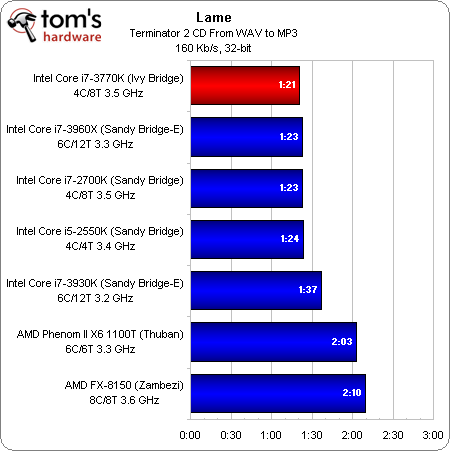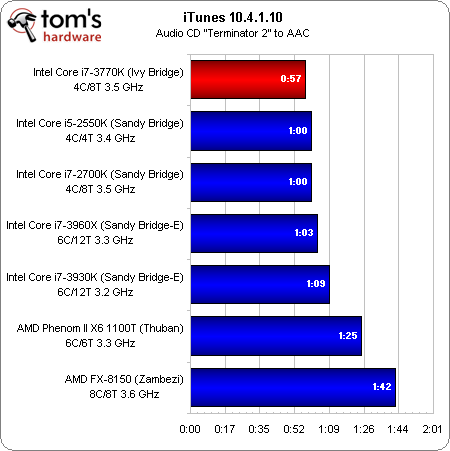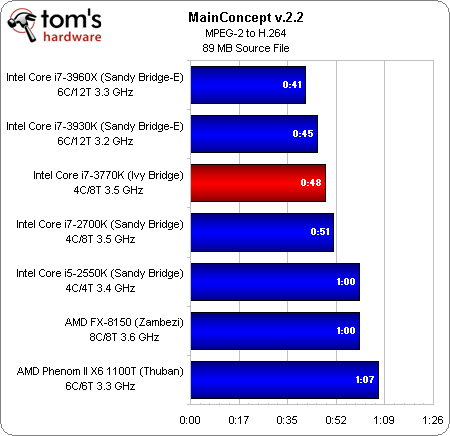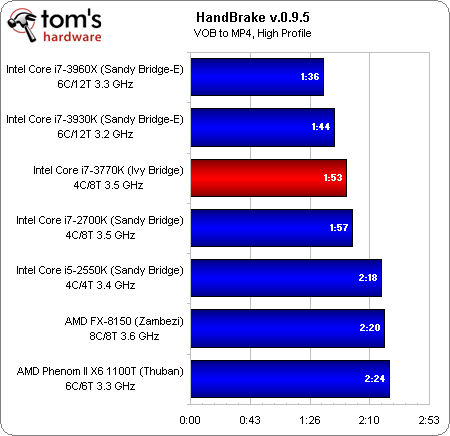Intel Core i7-3770K Review: A Small Step Up For Ivy Bridge
Benchmark Results: Media Encoding
Lame is another single-threaded title that we know will reward the most efficient architecture running at the highest clock rate.
Ivy Bridge, enjoying subtle IPC-oriented improvements, scores a narrow victory when Turbo Boost kicks in.
Because Core i7-3960X and Core i7-2700K hit similar single-threaded clocks, they show similarly in our Lame test.
Without overclocking, the Core i7-3930K can’t quite keep up to Intel’s Core i5-2550K (after all, six cores isn’t an advantage in a test only capable of taxing one).
We see a very similar situation play out in iTunes. Some of the Sandy Bridge-based chips swap places, but they’re all very, very close together. Most notable is that the Core i7-3770K takes first yet again.
The performance you can expect from Ivy Bridge is fairly easily characterized in one of two ways: lightly-threaded apps that favor an efficient architecture tend to show the design in a positive light against competing architectures at the same clock rate, while more parallelized workloads favor Sandy Bridge-E, so long as it wields more cores.
You’ll notice I left the -3820 out of this review altogether. I cannot come up with any situation where the -3820 is a product I’d recommend, even in a world without Ivy Bridge. If you’re going to spend big on Sandy Bridge-E, go for a six-core model, at least. If not, Sandy Bridge, Z68, and dual-channel memory kits are a better buy.
Get Tom's Hardware's best news and in-depth reviews, straight to your inbox.
MainConcept illustrates the reason why nicely. At stock clocks, there’s a nice, gradual progression from -3960X, -3930K, -3770K, and -2700K. The larger drop-off happens when you shift down to the -2550K and AMD’s offerings.
The exact same conclusion applies to HandBrake, a front-end for the x264 encoder. Intel’s six-core chips rock, though it’s easy to get good performance from the quad-core, Hyper-Threaded models when cash is more of a concern.
Current page: Benchmark Results: Media Encoding
Prev Page Benchmark Results: File Compression Next Page Benchmark Results: Batman: Arkham City-
tecmo34 Nice Review Chris...Reply
Looking forward to the further information coming out this week on Ivy Bridge, as I was initially planning on buying Ivy Bridge, but now I might turn to Sandy Bridge-E -
jaquith Great and long waited review - Thanks Chris!Reply
Temps as expected are high on the IB, but better than early ES which is very good.
Those with their SB or SB-E (K/X) should be feeling good about now ;) -
xtremexx saw this just pop up on google, posted 1 min ago, anyway im probably going to update i have a core i3 2100 so this is pretty good.Reply -
ojas it's heeearrree!!!!! lol i though intel wan't launching it, been scouring the web for an hour for some mention.Reply
Now, time to read the review. :D -
zanny It gets higher temps at lower frequencies? What the hell did Intel break?Reply
I really wish they would introduce a gaming platform between their stupidly overpriced x79esque server platform and the integrated graphics chips they are pushing mainstream. 50% more transistors should be 30% or so more performance or a much smaller chip, but gamers get nothing out of Ivy Bridge. -
JAYDEEJOHN It makes sense Intel is making this its quickest ramp ever, as they see ARM on the horizon in today's changing market.Reply
They're using their process to get to places they'll need to get to in the future -
verbalizer OK after reading most of the review and definitely studying the charts;Reply
I have a few things on my mind.
1.) AMD - C'mon and get it together, you need to do better...2.) imagine if Intel made an i7-2660K or something like the i5-2550K they have now.
3.) SB-E is not for gaming (too highly priced...) compared to i7 or i5 Sandy Bridge
4.) Ivy Bridge runs hot.......
5.) IB average 3.7% faster than i7 SB and only 16% over i5 SB = not worth it
6.) AMD - C'mon and get it together, you need to do better...
(moderator edit..) -
Pezcore27 Good review.Reply
To me it shows 2 main things. 1) that Ivy didn't improve on Sandy Bridge as much as Intel was hoping it would, and 2) just how far behind AMD actually is... -
tmk221 It's a shame that this chip is marginally faster than 2700k. I guess it's all AMD fault. there is simply no pressure on Intel. Otherwise they would already moved to 8, 6, and 4 cores processors. Especially now when they have 4 cores under 77W.Reply
Yea yea I know most apps won't use 8 cores, but that's only because there was no 8 cores processors in past, not the other way around




